A Guide to Knowledge Management Systems
Discover how modern knowledge management systems transform business operations. Learn how to choose, implement, and leverage the right KMS for growth.
A knowledge management system (KMS) is essentially the central brain for your entire organization. Its job is to systematically capture, organize, and share all the vital information that keeps your business running. It takes the mess of scattered data from emails, chat threads, and random folders and turns it into a strategic asset that everyone can actually use. This is precisely what platforms like Zemith are built to do—create a central hub that makes knowledge intuitive and actionable.
What Is a Knowledge Management System
Picture this: every ounce of your company's collective expertise—all the project discoveries, customer support fixes, and hard-won best practices—is spread across dozens of digital nooks and crannies. An engineer in one department spends a week wrestling with a problem that another team already solved last year. The solution exists, but it's buried deep in an old chat log, completely lost.
Sound familiar? This is a classic, and frustrating, business problem: information chaos. A knowledge management system is the answer.
It's so much more than a digital filing cabinet. A simple shared drive can store files, sure, but a KMS gives them context and makes them discoverable. It’s the difference between a random pile of books on the floor and a library with a skilled librarian who can point you to the exact page you need in seconds.
The Problem of Scattered Information
When there's no central system in place, organizations constantly bleed knowledge and repeat work. Critical information gets siloed within teams or, even worse, locked away in the head of a single employee. When that person eventually leaves, their expertise often walks out the door with them.
One study on business collaboration revealed that employees who feel included in communication are nearly five times as likely to report higher productivity. But that's impossible when information isn't shared effectively. This failure to connect the dots creates several major headaches:
- Wasted Time: Teams burn through valuable hours just trying to track down information that should be easy to find.
- Redundant Work: Employees unknowingly duplicate efforts, solving the same problems again and again.
- Inconsistent Decisions: Without access to the same reliable data, different teams make choices based on incomplete or outdated information.
- Poor Onboarding: New hires are left to fend for themselves, struggling to get up to speed without a structured library of company knowledge.
A KMS tackles these issues head-on by creating a single source of truth. It ensures that your organization's collective intelligence is preserved, shared, and built upon over time, turning it into a real competitive advantage.

How a KMS Creates a Central Brain
At its core, a KMS works by managing the entire lifecycle of knowledge—from creation to retirement. It’s not just about storage; it's about making information genuinely useful. The system actively captures insights from all kinds of sources, structures them so they're easy to search, and delivers them to the right person right when they need it. For example, an actionable KMS like Zemith allows a support agent to instantly find a detailed troubleshooting guide while they're live on a call with a customer.
To make all of this happen, you need high-quality, structured information to begin with. The ability to produce clear, discoverable documentation is the bedrock of any good KMS. Our guide on how to write technical documentation walks through practical steps for creating content that truly powers your system.
A great KMS pulls together different activities to create a unified, intelligent system. Here’s a quick look at the core functions.
Core Functions of a Knowledge Management System
A summary of the primary activities a KMS performs to manage organizational knowledge effectively.
| Function | Description | Actionable Impact with Zemith |
|---|---|---|
| Knowledge Capture | Actively collecting explicit (documents, reports) and tacit (expertise, insights) knowledge. | Prevents knowledge loss from employee turnover and captures valuable, unwritten expertise. |
| Knowledge Organization | Structuring and categorizing information with tags, metadata, and hierarchies for easy navigation. | Drastically reduces search time and ensures users can find relevant information quickly. |
| Knowledge Sharing | Distributing information to the right people through search, notifications, and collaborative tools. | Breaks down information silos, fosters collaboration, and promotes consistent practices. |
| Knowledge Application | Integrating knowledge into daily workflows to help employees make better, more informed decisions. | Improves decision-making speed and quality, leading to better business outcomes. |
Ultimately, by centralizing expertise and making it accessible, a KMS like Zemith frees up your team to stop hunting for answers and start driving real innovation. To learn more about platforms built specifically for this purpose, exploring dedicated technical knowledge management software can provide some excellent insights.
Why Investing in a KMS Is No Longer Optional

It's one thing to understand what a knowledge management system is, but it’s another to grasp why it's become a non-negotiable tool for any serious business. In today's economy, the speed and quality of your decisions are what set you apart. Trying to operate with information scattered across emails, hard drives, and people’s heads isn't just inefficient—it’s a direct route to falling behind.
The case for a KMS isn’t about adding another flashy piece of software; it's about building a core operational engine that delivers real, measurable results to your bottom line.
The real magic of a knowledge management system is how it turns your company's collective memory from a fleeting, fragile liability into a permanent, searchable asset. An actionable platform like Zemith makes everyone in your organization smarter and more effective, directly fueling productivity and better decision-making.
Think about the hidden costs of not having one. Every time an employee spends an hour hunting for a document, interrupts a colleague to ask a question that's been answered a dozen times, or reinvents a process from scratch, that’s money walking out the door. A KMS is designed to plug those leaks.
Connecting Efficiency to Your Bottom Line
The benefits of a well-implemented KMS aren't just abstract ideas; they show up in your financial and operational reports. When you centralize your company’s brainpower into a single, accessible platform like Zemith, you unlock some powerful efficiencies.
Let’s look at a few practical examples:
- Faster Employee Onboarding: Imagine new hires getting up to speed in days, not weeks, because they have a go-to library of training guides, process docs, and best practices. That’s a direct cut in onboarding costs and a much faster path to productivity.
- Eliminating Redundant Work: Your sales team needs the latest competitor analysis. Instead of building one from the ground up, they find a perfect, up-to-date version in seconds. That’s hours of duplicated effort saved, right there.
- Empowering Customer Support: Your support agents can solve issues on the first try because they have a comprehensive knowledge base at their fingertips. This doesn't just cut your cost-per-ticket; it creates happier, more loyal customers.
These aren't just minor improvements. They represent a fundamental shift where knowledge stops being a bottleneck and starts being an accelerator. To dig deeper into the full list of benefits, check out the key advantages of a Knowledge Management System.
The Rapidly Expanding Market for Knowledge
The business world is catching on fast, and the market growth is staggering. The global knowledge management market was valued at USD 667.46 billion in 2024 and is on track to explode to nearly USD 2.99 trillion by 2033.
This incredible growth, driven by a compound annual growth rate (CAGR) of roughly 18.12%, sends a powerful message. Companies are realizing that managing their intellectual capital is critical for survival and growth.
The trend is undeniable: businesses that drag their feet on adopting modern knowledge management systems are going to struggle. They’ll be stuck with slower innovation, higher operating costs, and an inability to adapt as quickly as their more organized competitors. Putting a solid KMS in place, especially an all-in-one platform like Zemith, is no longer just a good idea—it’s a prerequisite for staying competitive.
7 Key Features of a Modern KMS Platform
Let's be honest, not all knowledge management systems are the same. A basic shared drive can hold files, sure, but a modern KMS is designed to help you actively find, use, and build upon your team's collective wisdom. It’s the difference between a messy digital junk drawer and a smart, self-organizing library. The right features are what turn a passive folder into an engine for getting things done.
A truly effective KMS is built with features that solve real-world problems like information chaos and wasted time. These are the tools that deliver tangible value, saving countless hours and preventing costly mistakes.
So, what should you look for? Here are the core features that define a powerful and effective KMS platform.
1. Intelligent and Contextual Search
If there's one feature that makes or breaks a KMS, it's the search function. A simple keyword search that just scans file names is a relic of the past. Today's platforms need intelligent search—think of it as a skilled digital librarian who understands what you mean, not just what you type. It gets the context behind your query.
Instead of just spitting out a list of documents, a great search tool will surface:
- Relevant project data from completely different departments.
- Expert contacts within the company who actually know about the topic.
- Specific answers buried inside long reports or slide decks.
- Related conversations from your team’s chat channels.
This kind of search dramatically cuts down on the time your team wastes hunting for information. Platforms like Zemith build this right in, scanning across all your connected content—documents, notes, and project data—to deliver the right answer instantly.
A powerful search function is the heart of a successful KMS. If users can't find what they need quickly and reliably, they won't use the system. An actionable insight is that the search must be faster and more effective than just asking a coworker, a standard that Zemith aims to exceed.
2. Robust Version Control
Working with outdated information isn't just frustrating; it can lead to serious, expensive mistakes. That's why version control is an absolutely critical feature. It ensures everyone is working from the most current and approved version of a document, every single time.
Just imagine your product team building from an old technical spec, or a sales rep quoting prices from last year's sheet. These are the kinds of errors that proper version management makes completely preventable. A good system gives you a clear audit trail of all changes, shows who made them, and lets you easily roll back to a previous version if needed. Zemith helps create this single source of truth that everyone can rely on.
3. Analytics and Usage Dashboards
How do you know if your KMS is actually making a difference? You measure it. A modern knowledge management system should come with built-in analytics that give you a clear view of how information is flowing through your organization.
With these dashboards, you can uncover key insights:
- What are the most searched-for topics? This points to where you might need better documentation.
- Which documents get the most views? This helps you identify your most valuable knowledge assets.
- Are there knowledge gaps? See what people are searching for but not finding.
- Who are your top contributors? This gives you a chance to recognize and reward your internal experts.
This data-driven approach, which is integral to platforms like Zemith, helps you continuously improve your knowledge base so it actually meets the evolving needs of your team. This chart shows just how much impact a well-run KMS can have on the numbers that matter.
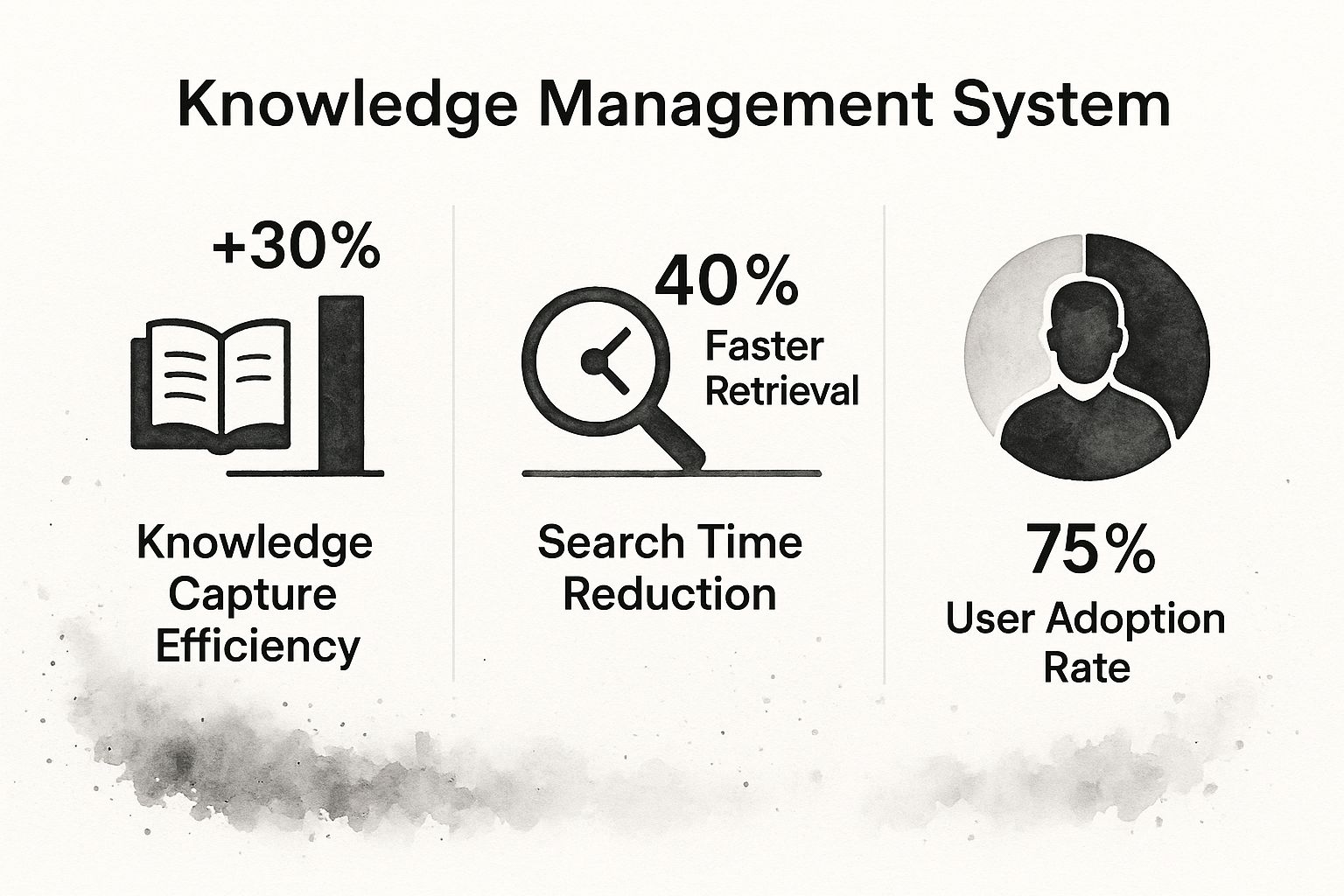
As the data shows, a properly implemented KMS drives real improvements across the board, from boosting efficiency to making employees feel more connected and capable.
4. On-Premises vs. Cloud-Based Deployment
When choosing a KMS, one of the first big decisions is where it will "live"—on your own servers (on-premises) or in the cloud (SaaS). This choice impacts everything from cost and security to scalability and maintenance. There's no single right answer; it really depends on your organization's specific needs, resources, and security protocols.
To help you weigh the options, here's a direct comparison of the two models.
On-Premises vs Cloud-Based Knowledge Management Systems
| Feature | On-Premises KMS | Cloud-Based KMS (like Zemith) | Best For |
|---|---|---|---|
| Setup & Cost | High initial investment in hardware and software. | Low upfront cost; subscription-based model. | Cloud is better for startups and SMBs; On-premise for enterprises with existing infrastructure. |
| Maintenance | Your internal IT team handles all updates, security, and maintenance. | The provider handles all updates, security, and maintenance. | Cloud is ideal for teams without a large, dedicated IT staff. |
| Scalability | Scaling requires purchasing and configuring new hardware. | Easily scalable; upgrade your plan with a few clicks. | Cloud offers superior flexibility for growing businesses. |
| Accessibility | Typically accessed only within the company network; remote access can be complex. | Accessible from anywhere with an internet connection. | Cloud is essential for remote and hybrid teams. |
| Control | Full control over data, security, and customization. | Data is stored on the provider's servers; control is based on the service agreement. | On-premise is preferred by organizations with strict data sovereignty or regulatory needs. |
Ultimately, the trend is moving toward the cloud for its flexibility and lower overhead. Zemith operates as a cloud-based solution, providing maximum accessibility and scalability for modern teams. However, on-premises solutions still hold a vital place for organizations with unique security and control requirements.
5. Seamless Integration Capabilities
Your KMS shouldn't be another island of information. To be truly useful, it has to connect with the tools your team already relies on every day—think project management software like Jira, communication hubs like Slack, or your CRM.
Integrations allow knowledge to be captured and used right where the work happens. For instance, a key decision made in a project update can be automatically saved to the KMS without anyone having to do it manually. This removes the friction of constantly switching apps and encourages a culture where sharing knowledge is second nature. Zemith is built as an all-in-one workspace, which helps centralize these functions to keep knowledge tied directly to action.
6. Content Creation and Curation Tools
A KMS isn't just for storing existing information; it's also where new knowledge is born. Look for a system with intuitive content creation tools that make it easy for anyone—not just technical writers—to contribute. This includes rich-text editors, templates for recurring documents (like meeting notes or project briefs), and the ability to easily embed media.
Equally important are curation features. These allow subject matter experts to review, tag, and organize content to ensure it's accurate, easy to find, and relevant. This "digital gardening" prevents the knowledge base from becoming a tangled mess of outdated or irrelevant files. An actionable tip is to choose a platform like Zemith that simplifies content creation, empowering everyone to contribute.
7. Security and Access Controls
Your company's knowledge is one of its most valuable assets, so protecting it is non-negotiable. A robust KMS must offer granular access controls. This means you can define exactly who can view, edit, and share specific information.
You might want your entire company to see product marketing materials, but restrict access to sensitive financial reports to just the leadership team. These permissions ensure that the right people have access to the right information, safeguarding confidential data while still promoting open collaboration where appropriate. This level of control is a core security feature in platforms like Zemith.
The demand for these kinds of secure, integrated, and efficient solutions is what’s fueling the market's growth. The Knowledge Management Systems (KMS) market is on track to hit approximately $3.66 billion in 2025, growing at a compound annual growth rate (CAGR) of 11.4% through 2033. This boom is all about the push for smarter collaboration and the move toward flexible, cloud-based tools. You can read more on the KMS market forecast to dig deeper into the trends.
The Role of AI in the Future of Knowledge Management

For a long time, traditional knowledge management systems have been little more than digital filing cabinets. Sure, they can store a ton of information, but they’ve always relied on people to do the heavy lifting—organizing everything, finding what’s needed, and connecting the dots.
But that’s changing, and Artificial Intelligence is at the heart of it. AI is transforming the KMS from a static warehouse into a dynamic, intelligent partner that practically anticipates your needs. It breathes life into your company's collective brain, turning a system that just holds knowledge into one that actively delivers it. Instead of you having to search for what you think you need, an AI-powered platform can surface critical information you didn't even know existed.
The real shift with AI is moving from reactive information retrieval to proactive knowledge delivery. An AI-powered KMS like Zemith doesn't just wait for you to ask a question; it learns your role, understands your current project, and provides the answers before you even have to ask.
This intelligent layer takes over the manual, time-sucking tasks that have always made knowledge management feel like a chore.
Automation and Intelligent Organization
One of the most immediate wins with AI is its knack for automating organization, especially at scale. Think about it: you upload hundreds of project documents, interview transcripts, and market research reports. An AI-powered KMS can instantly scan, understand, and apply the right tags to every single one. This AI-powered content tagging erases hours of tedious manual work and, more importantly, ensures everything is categorized consistently and accurately.
This automation isn't just for existing documents, either. It extends to capturing information as it’s created. For instance, by leveraging AI to take meeting notes, those discussions can be fed directly into your KMS, creating a searchable, permanent record of every key decision. Platforms like Zemith are built with this AI-first approach, making sure knowledge is captured and structured from the very beginning, not as an afterthought.
Personalized Knowledge Delivery
AI also unlocks a level of personalization that just wasn't possible before. A smart recommendation engine built into a KMS can look at your role, your team, and what you’re working on right now to push relevant information your way.
Here’s what that looks like in the real world:
- A new software developer logs in and is automatically greeted with onboarding guides, coding best practices, and a list of senior engineers on their team to connect with.
- A sales rep preparing for a big client call gets a feed with the latest competitor analysis, the most relevant case studies, and a summary of that client’s recent support tickets.
- A product manager receives a digest of recent customer feedback and feature requests that are directly related to their product line.
This kind of personalized delivery, which is a key goal for AI-driven platforms like Zemith, means your team spends far less time hunting for information and more time actually putting it to good use.
The Power of Conversational Queries
Perhaps the most user-friendly breakthrough AI brings to the table is Natural Language Processing (NLP). This is the tech that lets you talk to your KMS like you would a human expert. No more wrestling with clunky keywords or specific search syntax. You can just ask a question in plain English.
"What were our key takeaways from the Q3 client feedback sessions?"
The system doesn’t just hunt for keywords; it understands what you’re actually asking for. It retrieves not just a list of files but a synthesized answer, creating a much more natural and effective experience. This shift is already making waves across the industry, with AI and machine learning making systems smarter about discovery, content analysis, and putting knowledge to work.
Zemith has these capabilities baked into its core, letting you literally have a conversation with your documents and data. It transforms what used to be a frustrating search process into a simple, productive dialogue. For those who want to explore this further, our guide on the 12 best AI tools for research covers other powerful applications that can supercharge a great KMS.
A Practical Guide to Implementing a KMS
Getting a knowledge management system off the ground is less about the technology and much more about the people. I've seen brilliant platforms fail simply because nobody used them. The real goal isn't just installing software; it's about weaving knowledge sharing into the very fabric of your company culture.
This takes a smart, deliberate approach. It's about removing friction and showing people the "what's in it for me" from the very beginning. When done right, you turn a daunting project into a clear win for the business.
Start with Clear Objectives and Leadership Buy-In
Before you even glance at a demo, you have to answer one critical question: "What problem are we actually trying to solve?" Without a solid "why," your project will drift aimlessly.
Are you trying to:
- Slash the time it takes to get new hires up to speed?
- Cut down on the repetitive questions drowning your support team?
- Speed up development by sharing key engineering lessons?
- Stop precious expertise from walking out the door every time someone leaves?
Define your goals in a way you can measure. Don't just say "improve collaboration." A much stronger goal is "reduce the time employees spend searching for documents by 25% in the next six months."
With clear goals in hand, getting your leadership on board becomes much, much easier. Leaders care about business outcomes. If you can show them exactly how a KMS solves a major pain point or helps hit a key target, you’ll get the sponsorship you need to make it happen.
This executive support is absolutely critical. When leaders are seen actively using and championing the new system, it sends a powerful message to everyone else: this matters.
Assemble a Dedicated Implementation Team
Launching a KMS is not a side-hustle for the IT department. It demands a dedicated, cross-functional team—your "knowledge stewards"—who will own the process from beginning to end.
This team needs to be a mix of people from across the business, each bringing different skills to the table. You'll typically want:
- A Project Manager: To keep the train on the tracks, on time, and on budget.
- A Content Strategist: To figure out what information to move over, what to create from scratch, and how to organize it all.
- Department Champions: Enthusiastic volunteers from teams like Sales, HR, or Engineering who can build grassroots support among their peers.
- A Technical Lead: Someone to manage the nuts and bolts of migration and integration with other tools.
This group is your brain trust. They'll make the tough calls and ensure the system actually solves real problems for its users.
Plan Your Content Migration and Organization
One of the biggest hurdles you'll face is the mountain of existing information scattered across drives, inboxes, and wikis. The temptation is to just lift-and-shift everything into the new system. Don't do it. A messy old system just becomes a messy new one.
Instead, think like a curator. Start by identifying the most critical, high-value knowledge. Ask your teams, "What information do you waste the most time looking for?" Focus on getting that essential content into the KMS first. A clean, well-organized starting point is the fastest way to build trust with your users.
A solid content plan also means setting up a clear structure from day one. Define your categories, your tags, and your naming conventions. This upfront work pays off enormously down the road, making the system intuitive and search-friendly. A strong foundation in organizing information is vital; for a deeper dive, you can explore the principles in a practical guide to research data management, as many of the concepts apply here, too.
Execute a Strategic Rollout
Whatever you do, don't try to launch your new KMS to the entire company at once. A "big bang" rollout is a recipe for disaster, as any small hiccup gets magnified across the organization. A phased approach is always the smarter bet.
- Launch a Pilot Program: Start small. Pick one enthusiastic team—one of your "champion" departments is perfect for this—and let them be your guinea pigs. This lets you test everything in a real-world setting and work out the kinks on a manageable scale.
- Gather Feedback and Iterate: Use the pilot to learn. What’s working well? What’s confusing people? Use this direct feedback to make improvements before you go any wider. This shows employees you’re actually listening and building the system for them, not just at them.
- Expand in Phases: Once the pilot group is happy and successful, start rolling the KMS out to other departments one by one. Every successful rollout builds momentum and creates more internal advocates, making the next phase even easier.
Choosing a platform with a genuinely intuitive interface and great support, like Zemith, can make this whole journey dramatically simpler. An easy-to-use tool lowers the barrier to adoption, turning what could be a painful change into a smooth and successful one. By putting your people first and rolling out intelligently, you can ensure your knowledge management system becomes the central brain your organization can't live without.
A Few Common Questions About Knowledge Management
It's completely normal to have questions when you start exploring knowledge management. After all, you're not just buying another piece of software; you're fundamentally changing how your team accesses and shares its collective wisdom.
Let's clear up some of the most common questions we hear from teams who are considering a KMS for the first time.
How Can We Get Employees to Actually Use the New System?
This is the big one. A brilliant KMS that no one uses is just a waste of money. The secret isn't nagging or endless training sessions; it's making the KMS the path of least resistance.
If finding an answer in the KMS is genuinely faster and easier than tapping a coworker on the shoulder (or sending yet another Slack message), people will use it. It's that simple.
So, how do you get there?
- Make it part of the workflow. Don't force people to go to a separate website to find things. A system like Zemith weaves knowledge directly into your existing projects and team spaces, so the information is right there when you need it.
- Get leadership on board. When managers and executives visibly use the KMS to find information and share their own insights, it sends a clear message: "This is how we do things now."
- Launch with must-have content. Your KMS needs to be valuable from the moment it goes live. Before you launch, load it up with the stuff people are always asking for—critical process documents, answers to common customer questions, and essential SOPs. A good search function is a must.
When the system solves real, everyday problems and saves people time, you won't need to push for adoption. They'll pull it into their daily routines on their own.
Isn't a Shared Drive Good Enough? What's the Difference?
This is a classic point of confusion, and it’s a fair question. Think of a shared drive like Google Drive or Dropbox as a digital closet. It’s a place to store things. But over time, it gets messy, disorganized, and you have no idea what’s actually in there without opening every single box.
A Knowledge Management System, on the other hand, is more like an intelligent, living library. It’s built to organize and connect knowledge, not just files.
A shared drive can tell you where a file is located. A KMS can tell you what information is inside that file, who to ask about it, and why it's important for your current project. This is the core value proposition of an actionable platform like Zemith.
A modern KMS gives you capabilities that a simple drive just can't match:
- Intelligent Search: It doesn't just look for filenames; it understands what you're asking and finds answers buried deep inside documents and conversations.
- Version Control: No more wondering if you're looking at "Final_Report_v2" or "Final_Report_v3_final_final." A KMS ensures everyone sees the most up-to-date information.
- Usage Analytics: You can actually see which documents are most helpful and, more importantly, what information people are searching for but can't find.
- Quality Control: It allows you to set up review processes to make sure the knowledge being shared is accurate, approved, and reliable.
How Do We Measure the ROI of a KMS?
Calculating the return on investment for a KMS is a mix of hard data and real-world improvements. The value shows up in saved time, smarter decisions, and a lot less frustration across the board.
To build a solid case, you should measure a few key things before you roll out the system and then check back in a few months later. An actionable way to do this is to benchmark key metrics before implementing a tool like Zemith.
Quantitative Metrics (The Hard Numbers):
- Less Time Wasted Searching: Ask your team to estimate how much time they spend looking for information each week. A KMS can easily cut that down by 25% or more.
- Faster New Hire Onboarding: How long does it take a new employee to get up to speed? With a central knowledge hub, they can find their own answers and become productive much faster.
- Fewer Repetitive Questions: A good KMS acts as the first line of defense for support. When people can help themselves, it frees up your senior experts, IT, and HR teams to focus on more important work.
Qualitative Metrics (The Strategic Value):
- More Confident Decisions: When teams know they have reliable information, they can move forward without second-guessing themselves.
- Happier, Less-Stressed Employees: It’s frustrating not having the tools you need to do your job well. A KMS removes that friction and boosts morale.
- Better Collaboration: When information isn't locked away in department-specific silos, teams naturally start working together more effectively.
By tracking these areas, you can clearly show how a KMS isn't just a cost—it's an investment that pays for itself in efficiency and strategic advantage.
Ready to build your organization's central brain? With Zemith, you can consolidate your team's knowledge into a single, AI-powered workspace. Stop hunting for information and start making smarter, faster decisions. Explore how Zemith can transform your team's productivity today.
Explore Zemith Features
Introducing Zemith
The best tools in one place, so you can quickly leverage the best tools for your needs.
All in One AI Platform
Go beyond AI Chat, with Search, Notes, Image Generation, and more.
Cost Savings
Access latest AI models and tools at a fraction of the cost.
Get Sh*t Done
Speed up your work with productivity, work and creative assistants.
Constant Updates
Receive constant updates with new features and improvements to enhance your experience.
Features
Selection of Leading AI Models
Access multiple advanced AI models in one place - featuring Gemini-2.5 Pro, Claude 4.5 Sonnet, GPT 5, and more to tackle any tasks
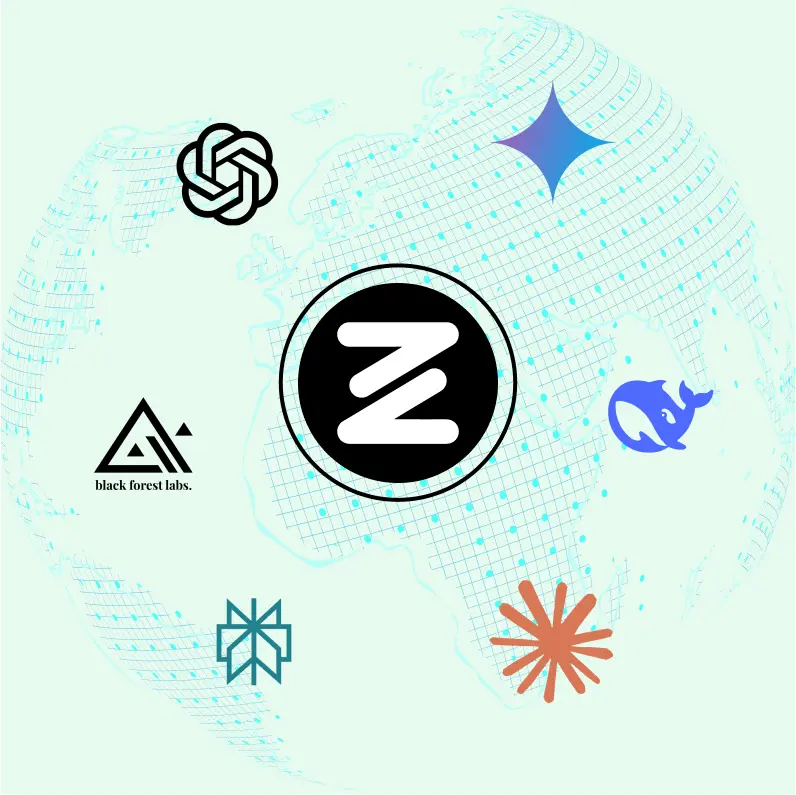
Speed run your documents
Upload documents to your Zemith library and transform them with AI-powered chat, podcast generation, summaries, and more
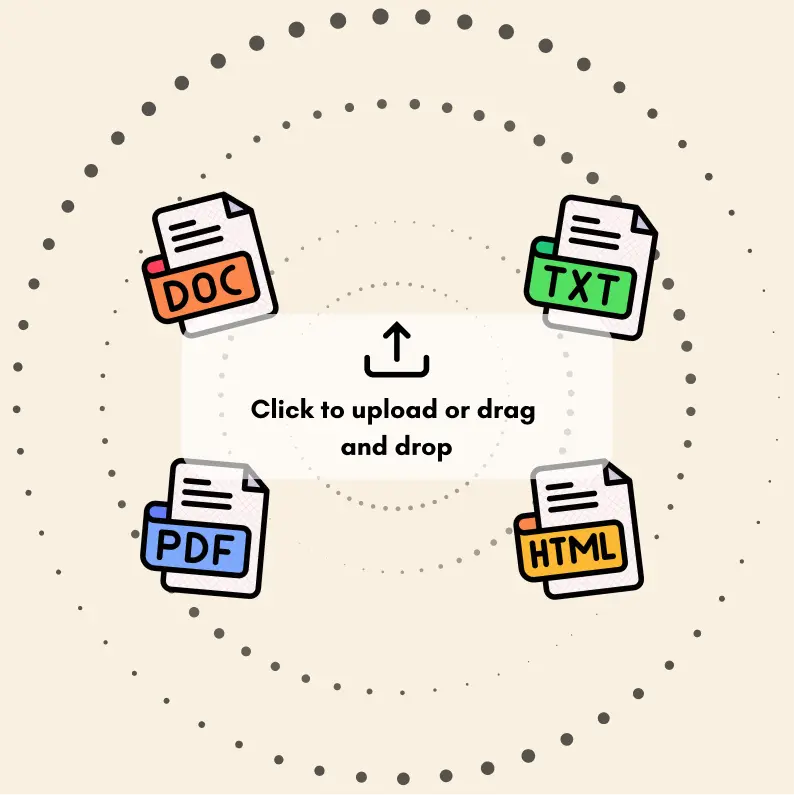
Transform Your Writing Process
Elevate your notes and documents with AI-powered assistance that helps you write faster, better, and with less effort
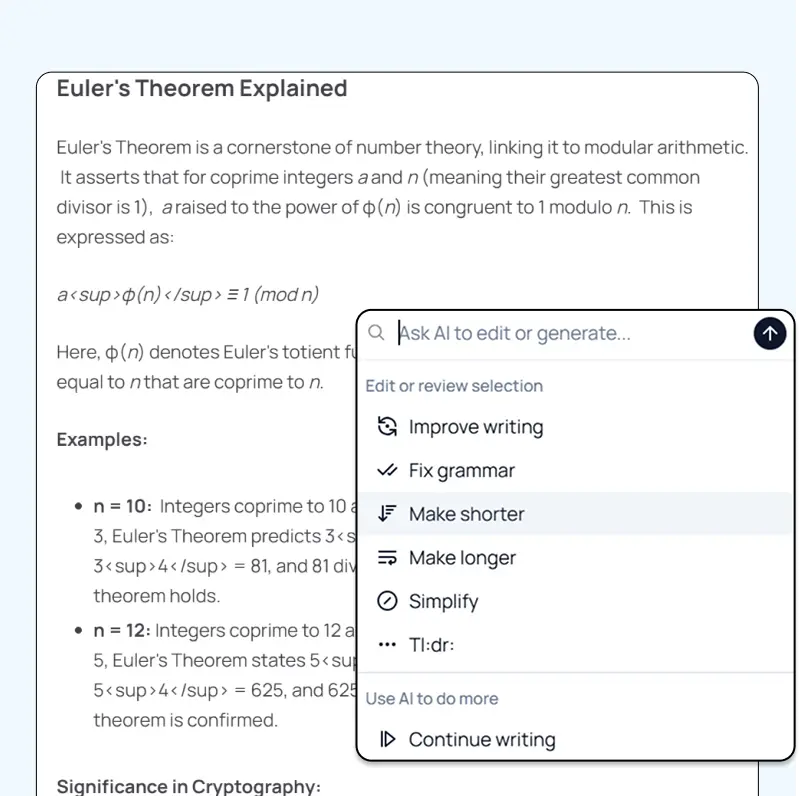
Unleash Your Visual Creativity
Transform ideas into stunning visuals with powerful AI image generation and editing tools that bring your creative vision to life
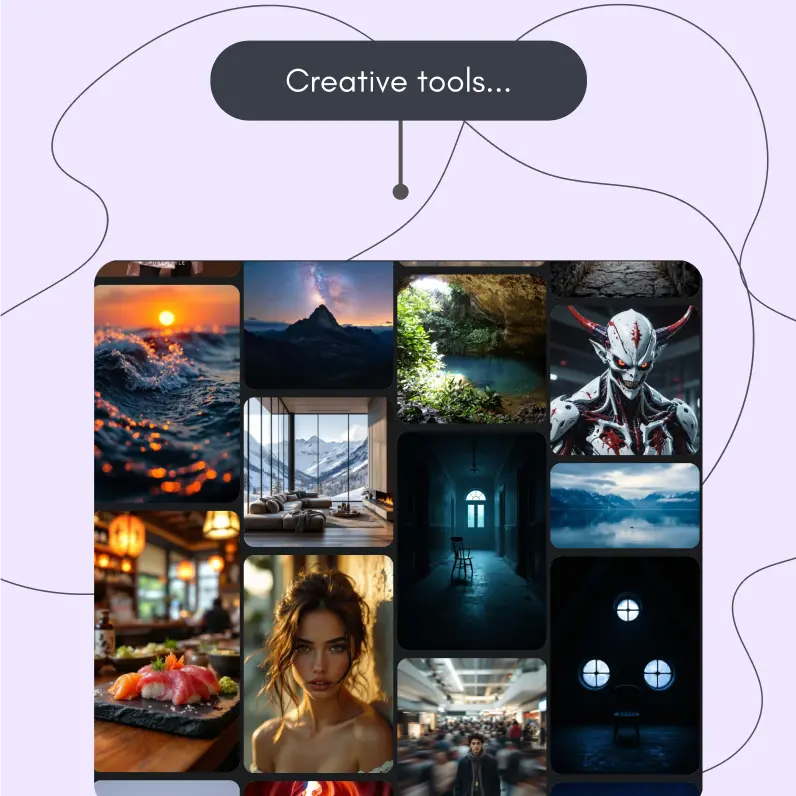
Accelerate Your Development Workflow
Boost productivity with an AI coding companion that helps you write, debug, and optimize code across multiple programming languages
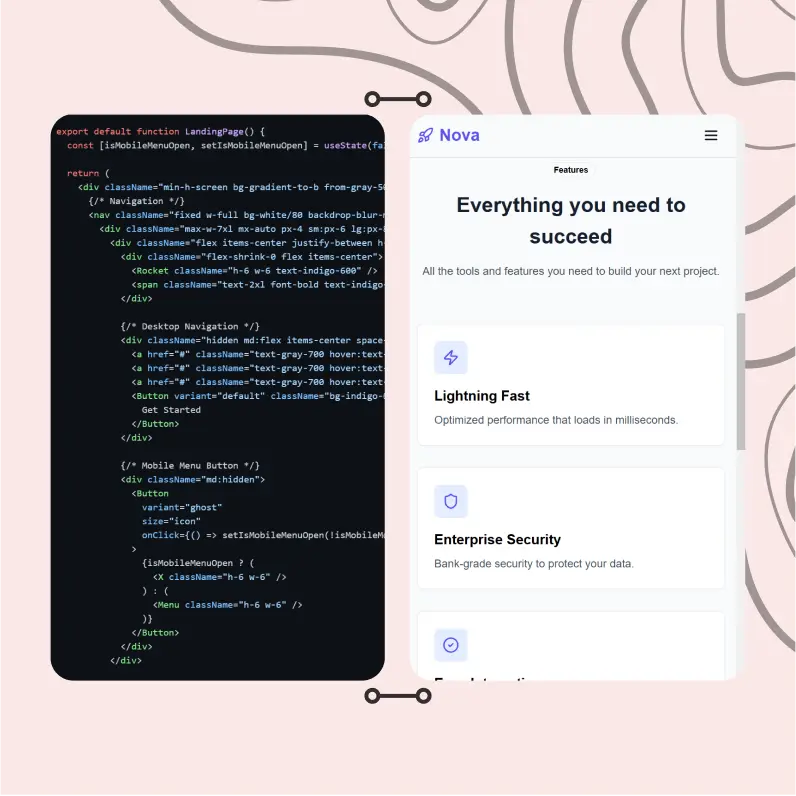
Powerful Tools for Everyday Excellence
Streamline your workflow with our collection of specialized AI tools designed to solve common challenges and boost your productivity
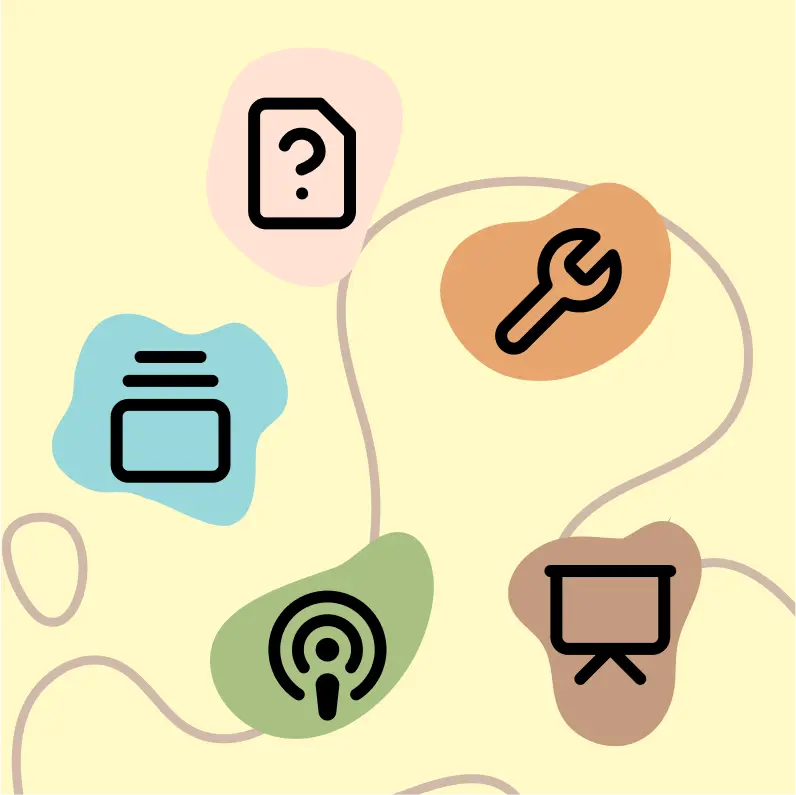
Live Mode for Real Time Conversations
Speak naturally, share your screen and chat in realtime with AI
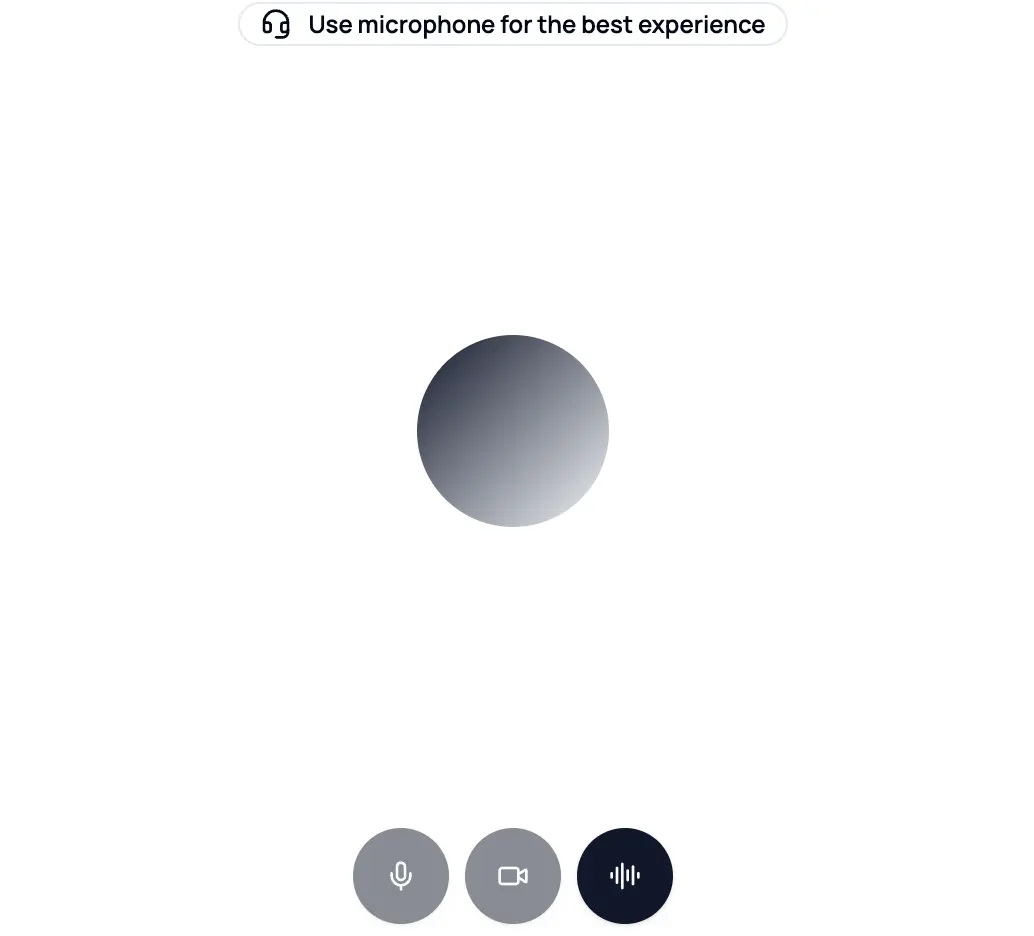
AI in your pocket
Experience the full power of Zemith AI platform wherever you go. Chat with AI, generate content, and boost your productivity from your mobile device.

Deeply Integrated with Top AI Models
Beyond basic AI chat - deeply integrated tools and productivity-focused OS for maximum efficiency
Straightforward, affordable pricing
Save hours of work and research
Affordable plan for power users
Plus
- 10000 Credits Monthly
- Access to plus features
- Access to Plus Models
- Access to tools such as web search, canvas usage, deep research tool
- Access to Creative Features
- Access to Documents Library Features
- Upload up to 50 sources per library folder
- Access to Custom System Prompt
- Access to FocusOS up to 15 tabs
- Unlimited model usage for Gemini 2.5 Flash Lite
- Set Default Model
- Access to Max Mode
- Access to Document to Podcast
- Access to Document to Quiz Generator
- Access to on demand credits
- Access to latest features
Professional
- Everything in Plus, and:
- 21000 Credits Monthly
- Access to Pro Models
- Access to Pro Features
- Access to Video Generation
- Unlimited model usage for GPT 5 Mini
- Access to code interpreter agent
- Access to auto tools
- 10000 Credits Monthly
- Access to plus features
- Access to Plus Models
- Access to tools such as web search, canvas usage, deep research tool
- Access to Creative Features
- Access to Documents Library Features
- Upload up to 50 sources per library folder
- Access to Custom System Prompt
- Access to FocusOS up to 15 tabs
- Unlimited model usage for Gemini 2.5 Flash Lite
- Set Default Model
- Access to Max Mode
- Access to Document to Podcast
- Access to Document to Quiz Generator
- Access to on demand credits
- Access to latest features
- Everything in Plus, and:
- 21000 Credits Monthly
- Access to Pro Models
- Access to Pro Features
- Access to Video Generation
- Unlimited model usage for GPT 5 Mini
- Access to code interpreter agent
- Access to auto tools
What Our Users Say
Great Tool after 2 months usage
simplyzubair
I love the way multiple tools they integrated in one platform. So far it is going in right dorection adding more tools.
Best in Kind!
barefootmedicine
This is another game-change. have used software that kind of offers similar features, but the quality of the data I'm getting back and the sheer speed of the responses is outstanding. I use this app ...
simply awesome
MarianZ
I just tried it - didnt wanna stay with it, because there is so much like that out there. But it convinced me, because: - the discord-channel is very response and fast - the number of models are quite...
A Surprisingly Comprehensive and Engaging Experience
bruno.battocletti
Zemith is not just another app; it's a surprisingly comprehensive platform that feels like a toolbox filled with unexpected delights. From the moment you launch it, you're greeted with a clean and int...
Great for Document Analysis
yerch82
Just works. Simple to use and great for working with documents and make summaries. Money well spend in my opinion.
Great AI site with lots of features and accessible llm's
sumore
what I find most useful in this site is the organization of the features. it's better that all the other site I have so far and even better than chatgpt themselves.
Excellent Tool
AlphaLeaf
Zemith claims to be an all-in-one platform, and after using it, I can confirm that it lives up to that claim. It not only has all the necessary functions, but the UI is also well-designed and very eas...
A well-rounded platform with solid LLMs, extra functionality
SlothMachine
Hey team Zemith! First off: I don't often write these reviews. I should do better, especially with tools that really put their heart and soul into their platform.
This is the best tool I've ever used. Updates are made almost daily, and the feedback process is very fast.
reu0691
This is the best AI tool I've used so far. Updates are made almost daily, and the feedback process is incredibly fast. Just looking at the changelogs, you can see how consistently the developers have ...
